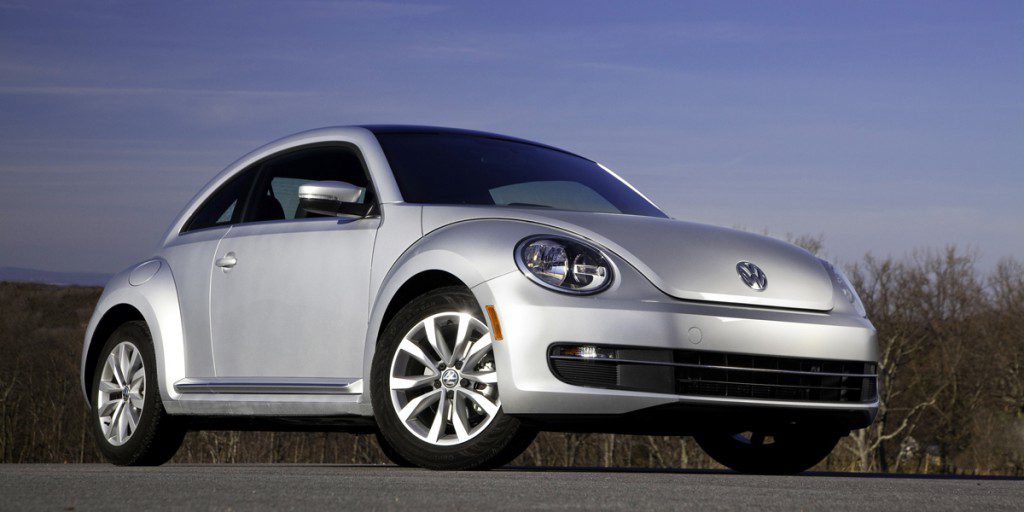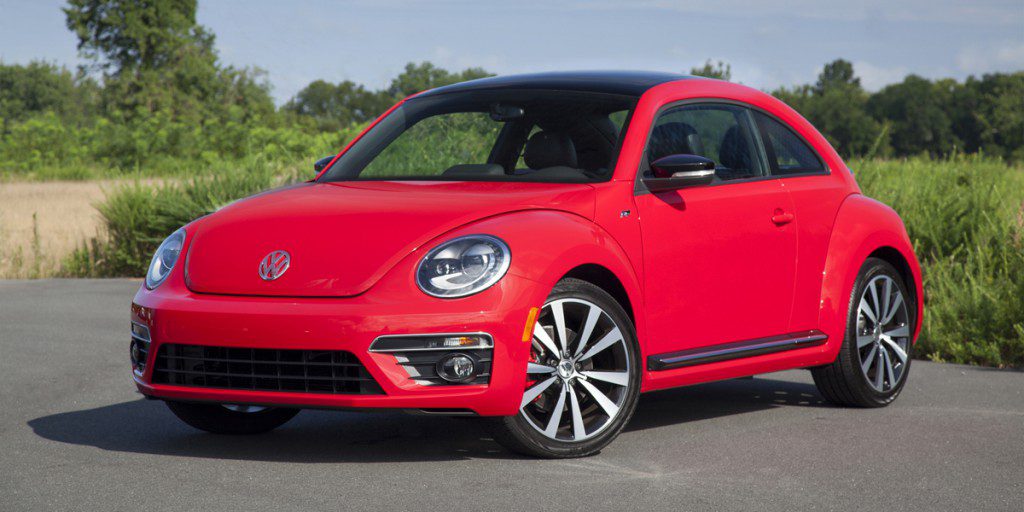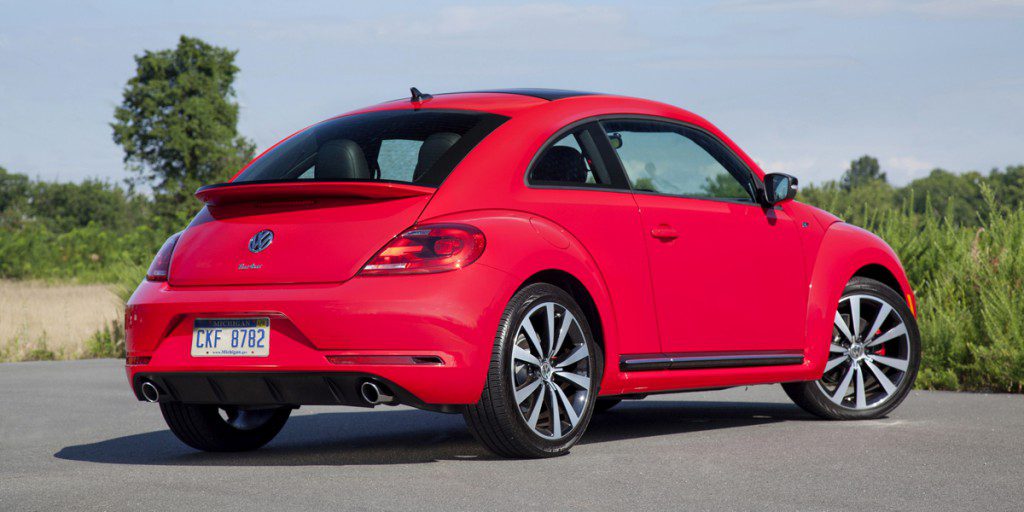| Sporty/performance car; Built in |
|
|
|
| Good condition price range: $8,500 – $22,000* |

2014 Volkswagen Beetle

2014 Volkswagen Beetle R-Line

2014 Volkswagen Beetle R-Line

2014 Volkswagen Beetle
| Pros: |
|
| Cons: |
|
This Beetle is just as style-driven as the New Beetle was, but it’s also more practical in everyday terms, feels more substantial, and is arguably better to drive. Trouble is, a comparably equipped version of the related Golf or Jetta offers many of the same virtues, plus far better rear-seat and cargo room. Where the Beetle really shines is in convertible form. So what we have here is another nostalgia trip that makes sense if you love the styling, and can accept the compromises that go with it. Our hearts like the frugal diesel-powered TDI models, but our heads tell us the best value is in the base 2.5 and 1.8T models.
Overview
The 2012 Volkswagen Beetle was redesigned with freshened styling, new engines, and some added features. The 2012 model is about 1 inch longer in wheelbase, 7 inches longer overall, and more than 3 inches wider than the 1998-2010 Volkswagen New Beetle.
The 2012 Beetle was offered in three trim levels: Base, 2.5L, and 2.0T Turbo.
Base models came equipped with a few noteworthy features, including a tilt-and-telescopic leather-wrapped steering wheel, heated power mirrors, 17-inch tires, and alloy wheels.
The 2.5L added vinyl upholstery, heated and height-adjustable front seats, driver-seat lumbar adjustment, iPod interface system, wireless cell-phone link, and more. The 2.5L Sunroof added a power sunroof, satellite radio, and other features. The 2.5L Sunroof/Sound/Navigation added a navigation system, Fender sound system, and 18-inch tires.
The 2.0T Turbo added the following to 2.5L: a turbocharged engine, rear spoiler, sport suspension, 18-inch tires, and more. The 2.0T Turbo Launch Edition included unique interior and exterior trim and 19-inch tires. The 2.0T Turbo Sunroof/Sound added the following to 2.0T Turbo: a power sunroof, Fender sound system, satellite radio, and more. The 2.0T Turbo Sunroof/Sound/Navigation added a navigation system.
Note that trim levels equipped with a sunroof, Fender sound system, and/or navigation were priced as separate models.
A Lamp and Wheel Package (bi-xenon headlights, 19-inch tires) was the sole factory option package. It was only available on the top-line 2.0T Turbo Sunroof/Sound/Navigation model.
Base and 2.5L models came equipped with a 170-horsepower 2.5-liter 5-cylinder with either a 5-speed manual or 6-speed automatic transmission. 2.0T Turbo models had a 200-horsepower 2.0-liter turbocharged 4-cylinder mated to either a 6-speed manual or a 6-speed dual-clutch automated-manual transmission that behaves much like an automatic. Volkswagen recommended regular-grade gas for the 2.5, and premium for the 2.0 turbo. Beetle is front-wheel drive.
The EPA rated the 5-cylinder 2012 Beetle with manual transmission at 22 mpg city/31 mpg highway—22/29 for the automatic. The turbocharged 4-cylinder models were rated at 21/30 with manual transmission and 22/30 with automatic.
Volkswagen recommended regular-grade gas for the 2.5, premium for the 2.0 turbo.
The 2012 Beetle had a standard complement of expected and federally mandated safety features. All manual-transmission models came standard with a hill-holder clutch.
Yearly Updates
| 2012 Beetle VW announced turbodiesel TDI versions as early-2013 models and a new Turbo R-Line variant as a late-year addition. Another mid-year tweak for Turbo versions was a new engine with 10 more horsepower, bring the total to 210. The only other changes among Beetle coupes involved shuffling features, and adding a special Fender Edition package created with the noted maker of electric guitars and amplifiers. But the major news was the debut of a Beetle Convertible. In addition to several 2.5, TDI, and Turbo models, three special-edition Beetle Convertible “decade” models were also available. Each was meant to recall a specific decade when the original bug was available in America–the 1950s, the 1960s, and the 1970s. The ’50s Edition Beetle Convertible was a base 2.5 model painted black and finished with a tan leather-trimmed interior. It also included chrome side mirror housings and “Heritage” wheels. The ’60s Edition Beetle Convertible was based on the top-line Turbo with Sound and Navigation variant. It featured Denim Blue paint with two-tone leather sport seats. The ’60s Edition was only available with the DSG automated-manual transmission. The final special Beetle was the ’70s Edition. This model was a 2.5 with Sound and Navigation and added chrome exterior mirrors, unique Toffee Brown metallic exterior paint, and leather interior trim. |
| 2013 Beetle The 2.5-liter 5-cylinder engine was phased out during 2014, and a 1.8-liter turbocharged 4-cylinder became Beetle’s base engine. Since the base engine was now a turbo, the existing Beetle 2.0T Turbo models were renamed R-Line. There was also a new limited-edition GSR model. New features included an available rearview camera and Volkswagen’s Car-Net communications system/smartphone app. All Beetle models now used a multi-link independent rear suspension; previously Beetle 2.5L and TDI coupes used a torsion beam rear axle. |
